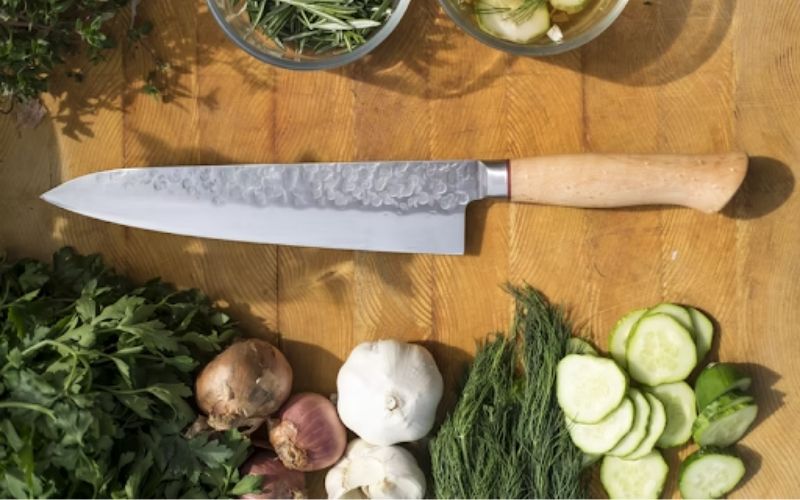Note: All Orders Must Be Above £30.00.
No products in the basket.
Free Delivery from £60
To see if you are eligible for free delivery, read our delivery terms here.
The Chef knife (also sometimes known as a standard kitchen knife) is a common kitchen utensil which no doubt all professional chefs or kitchen rookies use for cooking and kitchen applications. It is a user’s best friend when it comes to the kitchen and should be nurtured at all costs. With this in mind, have you ever thought about what the different parts of a knife is? Well if you have, this article will gladly supply you with all the facts and technological terms used for each part of a chef’s knife and how to choose the right kitchen knife for you.

Firstly, it is important to note that kitchen knives vary in length ranging from 6-12 inches so some properties of the utensil will be larger than others. With this in mind, we have listed the different parts of a kitchen knife which is can be seen below:
The handle (along with the blade which we will get onto later) is probably the most important anatomic feature on a kitchen knife. Having a handle that is durable, feels nice when you grip it and has unique indentations will ultimately assist you in all kitchen settings.
The blade of your kitchen knife needs to be securely connected to the handle. This is done by the tang which is the part of the blade that extends inside the handle. Without the handle, comfortability diminishes when holding the blade. Equally without the tang, the blade simply cannot be connected and be inserted into a handle for free range of movement. As a side note, you can have different variations of tangs. One of the most interesting variants is the skeletal tang which is incredibly light due to its large holes in the centre of it and are surprisingly strong even though most of the steel is removed.
Rivets are simply the cylindrical studs that keep the handle securely attached to the tang portion of the knife. One tip for rivets is make sure that their tops are smooth and don’t interfere with your hand when gripping the handle otherwise this could have adverse effects when using the knife.
The bolster is where the handle and the blade of the knife meet. The bolster’s primary function is to keep the fingers of your gripping hand away from the blade when in application. This thicker and unsharpened portion of the blade can continue all the way to the heel of the knife (discussed next) adding to the weight and balance. Finally, the bolster has a secondary use in which it forces the user to hold the knife correctly, which makes cutting more comfortable and efficient.
The heel of your knife is at the bottom of the bolster and is the broadest part of the blade. The heel gives you a place to rest the back of the knife and is also where you would bring down the knife to start the motion of your chopping or mincing.
The spine is the top portion of the blade. It is actually quite an important property of the kitchen utensil as it allows you to put pressure on the knife and what you are cutting without cutting your hand. It also helps with your grip and is thicker than the cutting edge of the knife.
This is the length of the blade that does the cutting and the opposite side to the spine. Chef knives feature a gentle curve from the top of the blade to the bolster that helps maintain a smooth back-and-forth rocking action – appropriate for chopping.
When it comes to choosing the right kitchen knife for you, personal preferences will certainly be a major factor. While there is no agreed universal ‘best’ chef’s knife on offer in today’s market, the knife you select will be one that you utilise for many years to come. As such, it is important that you invest in a knife that matches your each and every need. With this in mind, there are three major components to consider when choosing your kitchen knife.
If you’re a smaller sized kitchen user, you’ll want to look for a shorter length knife. The most common choice is an 8-inch chef’s knife and a general rule of thumb is ‘the shorter the blade length, the more agile it will feel’. Bear this in mind when selecting your trusty knife.
The handle of a kitchen knife carries more weight than the blade, but the knife shouldn’t be weighted toward the back of the handle or toward the blade. This would force you to compensate for the imbalance as you use it which is not ideal as you can be prone to serve injuries. Instead, look for a chef’s knife that’s weighted toward the knife’s bolster or heel.
A heavier knife uses weight and gravity to cut through food easier while a chef’s knife that weighs less offers more manoeuvrability but less chopping power. Again bear this in mind when selecting your knife depending on whether you want full manoeuvrability or raw power when using your knife.